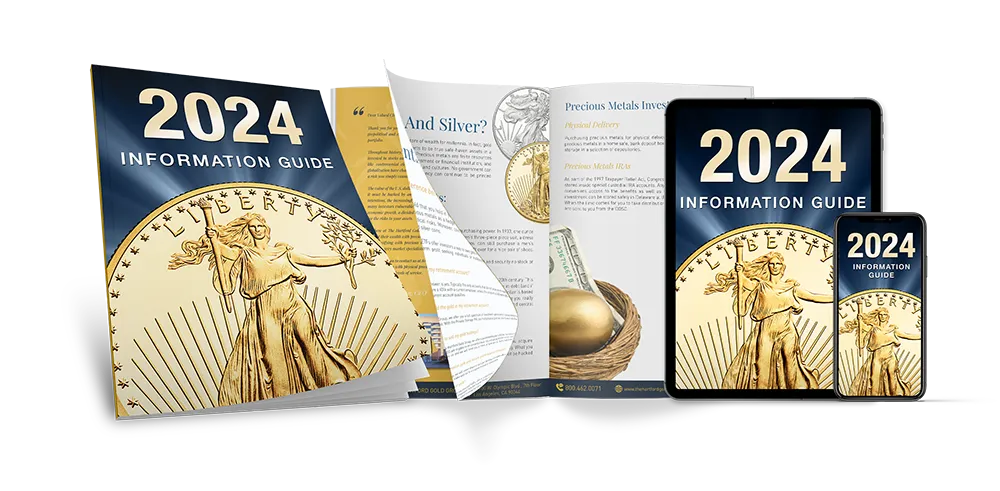Understanding the fluctuations in gold prices is crucial for both seasoned and beginner investors. Gold, a cornerstone of the precious metals market, has historically been a symbol of wealth and a hedge against economic uncertainty.
However, like any asset class, gold prices experience fluctuations influenced by many factors. This article aims to cover when and why gold prices drop and offer insight into the mechanics behind gold’s valuation and its economic implications.
How Is the Price of Gold Determined?
The price of gold is driven by a combination of factors that influence its value in the global market. Here’s a breakdown:
Supply and Demand
The basic economic principle of supply and demand heavily influences gold prices. When gold mining companies increase production or central banks sell gold from their reserves, it can increase supply, potentially lowering prices. Conversely, high demand from investors, industries, or central bank purchases can raise prices.
Political Events and Economic Indicators
Uncertainty from geopolitical tensions or economic instability often leads investors to seek safe-haven assets like gold, increasing demand and price. Significant events like wars or financial crises can increase gold buying.
Interest Rates and Monetary Policies
The interest rates set by central banks, especially the U.S. Federal Reserve, also known as the Fed, impact gold prices. High interest rates increase the opportunity cost of holding non-yielding assets like gold, potentially decreasing its price. In turn, low interest rates can make gold a more attractive investment.
Value of the U.S. Dollar
Gold is typically priced in U.S. dollars, so the strength of the dollar affects its price globally. A strong dollar makes gold more expensive for foreign investors, reducing demand and price. A weaker dollar can increase demand and push prices higher.
Investor Expectations
Investors’ expectations about future economic conditions, such as inflation or economic growth, can influence their desire to hold gold for a specific time. Expectations of high inflation can drive investors towards gold as a store of value, increasing its price.
International Market Trading
By trading futures contracts and exchange-traded funds (ETFs), gold prices are set in international currency markets, such as China’s Renminbi, The London Bullion Market, and the New York Mercantile Exchange (NYMEX). These trading activities reflect real-time shifts in global supply, demand, and investor sentiment, directly impacting the price of gold.
Central Bank Actions
Central banks hold significant gold reserves, and their buying or selling activities can influence global gold prices. Purchases by central banks can signal confidence in gold as a reserve asset, potentially driving up its price.
Why Does the Price of Gold Drop?
Gold prices can drop due to various factors, often reflecting changes in the economic environment, investor behavior, and global market dynamics. Here’s a closer look at why gold prices might fall:
- Stronger U.S. Dollar Value: Since gold is typically priced in U.S. dollars, a stronger dollar makes gold more expensive for investors using other currencies, decreasing demand and lowering gold prices.
- Rising Interest Rates: Higher interest rates increase the opportunity cost of holding assets like gold. When the Fed or other central banks raise rates, investors may shift towards assets with higher yields, reducing demand for gold and causing its price to drop.
- Economic Growth: When economic indicators show growth and stability, investors prefer riskier assets like stocks over safe-haven assets like gold. Increased investor confidence in the economy or the stock market can reduce gold demand, lowering its price.
- Decreased Inflation: One of gold’s main attractions is that it’s a hedge against inflation. If inflation fears diminish due to effective monetary policy or other factors, the demand for gold as a protective asset can decrease, leading to a price drop.
- Reduced Geopolitical Tensions: Gold prices often rise amid geopolitical uncertainty. If tensions ease or resolve, the urgency to invest in gold for financial protection diminishes, potentially causing prices to fall.
- Market Liquidation: In times of market stress or when investors need to cover losses in other areas of their portfolio, they may sell gold holdings for liquidity, increasing the supply in the market and driving down prices.
What Does it Mean for the Economy?
A drop in gold prices can mean different things for the economy. One point is that lower gold prices can indicate economic stability, confidence, and growth, suggesting that investors are favoring higher-risk, higher-yield investments over more conservative investments like gold. This shift can reflect positive trends in consumer spending, corporate profits, and employment rates, contributing to overall economic health.
On the other hand, significant declines in gold prices, especially if driven by sudden increases in supply or drops in demand, might signal concerns about deflation. For central banks and governments, lower gold prices can affect the valuation of gold reserves, potentially impacting government monetary policy decisions and strategies for stabilizing and stimulating the economy.
Understanding the reasons behind changes in gold prices and their economic implications can help investors, policymakers, and consumers navigate financial decisions more effectively, balancing short-term responses with long-term economic goals.
Is Gold Expected To Rise in 2024?
According to Bloomberg, gold prices hit a record high in March 2024. Several key elements will play a crucial role in determining predictions of gold’s price for the rest of 2024. There are specific economic factors indicating gold prices may rise even more.
The Fed and central banks worldwide have a significant influence on gold prices through their monetary policy decisions. If central banks continue to adopt measures to combat inflation by keeping interest rates high or making further cuts, gold could become more attractive as a non-yielding asset, possibly driving its price up in 2024.
International economic tensions and slowdowns, or another episode of pandemic conditions, can lead to increased demand for safe-haven assets like gold. Situations in key regions such as Ukraine, China, and Russia, or global economic challenges, could contribute to economic uncertainty, potentially boosting gold prices.
Gold is traditionally seen as a hedge against inflation. If investors anticipate higher inflation in 2024 due to government intervention measures like a stimulus check or supply chain disruptions, demand for gold could increase, pushing its prices higher.
The strength of the U.S. dollar against other currencies influences gold prices. A weaker U.S. dollar makes gold cheaper for holders of other currencies, increasing demand and possibly increasing gold prices. Currency trends and central bank actions in 2024 will be important to keep an eye on.
Trends in financial markets, including the stock market, cryptocurrencies like Bitcoin, and other asset classes, also impact gold’s appeal. If investors seek diversification or if market volatility persists, gold could gain favor, contributing to a price increase.
Gold mining and recycling activities affect the supply side, while demand from investors, central banks, and industries (e.g., jewelry and technology) influences the demand side. Any significant changes in these dynamics could affect gold prices.
While these factors suggest potential upward pressure on gold prices in 2024, it’s important to note that the gold market is subject to rapid changes and can be influenced by unforeseen events.
Buyers considering gold as part of their assets should stay informed about global economic developments, monetary policies, and market trends to make well-informed decisions.
How To Buy Gold
Buying gold can be a strategic move to diversify your assets and safeguard your financial future against economic fluctuations. Here’s how you can get started.
Before purchasing gold, consider your objectives, risk tolerance, and time horizon. Whether you’re looking to hedge against inflation, possess a tangible asset, or simply diversify your portfolio, understanding your goals will guide your approach to buying gold.
You then have to choose an asset option. Gold comes in various forms, including physical gold (gold bullion coins, bars) and gold IRAs (Individual Retirement Accounts). Each has its advantages and considerations, such as liquidity, storage, and exposure to gold prices.
When buying physical gold, it’s crucial to work with reputable and reliable dealers to ensure authenticity and fair pricing. American Hartford Gold stands out as a leader in providing buyers with high-quality gold products. Their commitment to customer service, transparency, and competitive pricing makes them an excellent choice for both new and experienced buyers.
Understand that gold prices fluctuate based on market conditions. When purchasing physical gold, like gold bars, expect to pay a premium over the spot price, which covers the dealer’s costs and profit margin. American Hartford Gold offers transparent pricing and works to ensure that our clients receive fair value for their precious metal purchases.
The gold market is dynamic. Staying informed about market trends, economic indicators, and geopolitical events can help you make timely decisions about your gold purchase. American Hartford Gold provides valuable market resources to keep our clients informed and ready to act when opportunities arise.
Buying gold through American Hartford Gold offers a straightforward and secure way to diversify your assets and protect your wealth. With their expertise and commitment to customer satisfaction, they provide the guidance and support needed to navigate the gold market confidently. Contact American Hartford Gold today to learn more about how to start your gold-purchasing journey.
Sources:
Chinese Yuan Renminbi (CNY): Overview, History | Investopedia
The Independent Precious Metals Authority | LBMA
Gold Touches $2,100 as Traders Scoop Up Metal on Rate Cut Bets | Bloomberg






